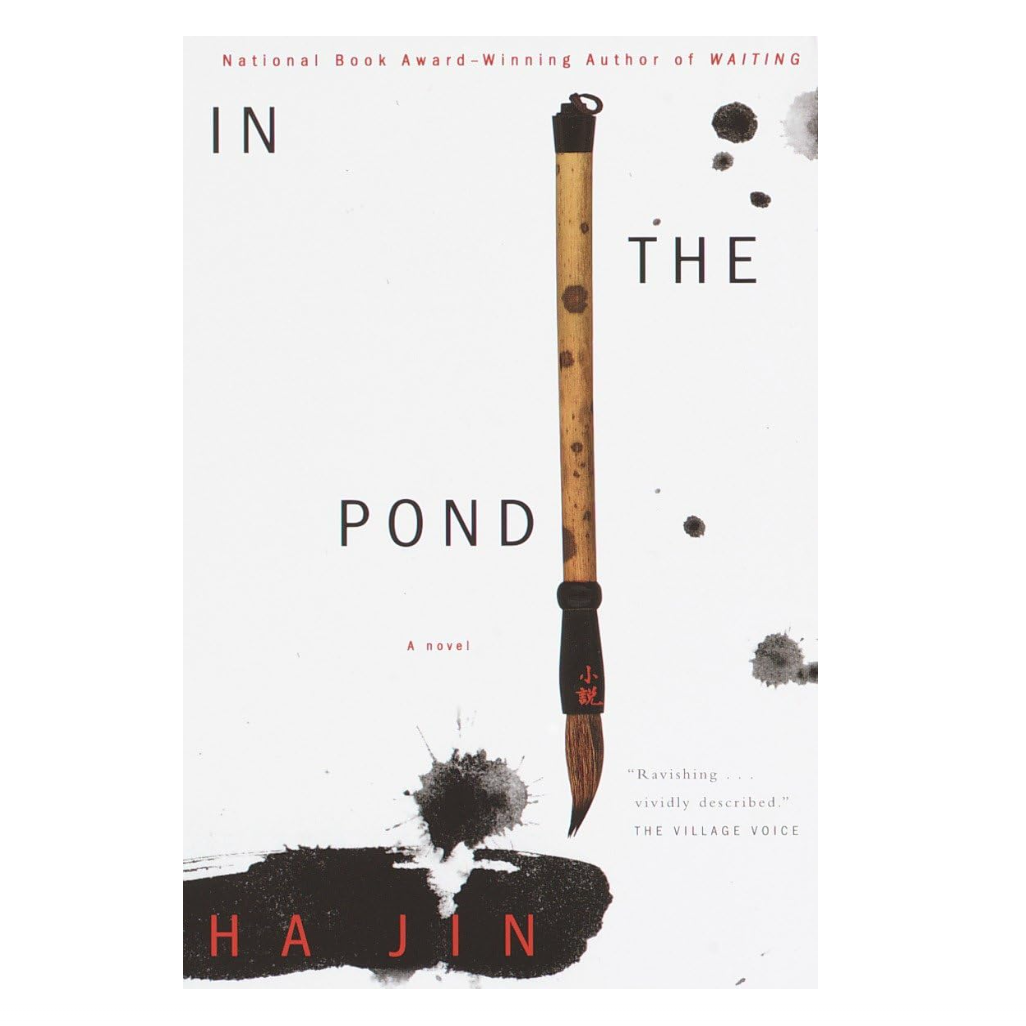I like the intimacy of first person. The direct connection with a character, the lack of any barriers between us – this tends to be what sucks me into a book. (It’s even better when the lines between reader and protagonist blur entirely, as in Ulysses or Liu Yichang’s The Drunkard.)
As I write my own stories, I tend to stick to first person narration, where crafting intimacy with a character feels more natural. With third person narratives, I struggle to land in that mysterious place where characters feel real – where I dwell within them, seeing from their eyes, tangled up in their thoughts.
Fortunately, the two things aren’t mutually exclusive. I’m always on the lookout for third person narratives that naturally introduce first person moments. I was delighted to find an example of this in Ha Jin’s novel In the Pond.
The protagonist, artist Shao Bin, has just been denied housing by the leaders of the fertilizer plant where he works. As he wrestles with how to fight this injustice, Bin turns to an ancient writer for counsel. What Bin reads sparks a decision – he will use his brush to resist. It is here that Ha Jin brings us directly into Bin’s mind in a brief but powerful first person encounter.
This was a helpful lesson for me – I hope you’ll also find it useful.
Bin closed the book, profoundly moved. Writing and painting belong to the same family of arts, he reasoned; they are both the work of the brush. Yes, to fight the evil is the essential function of fine arts. As an artist and scholar I ought to oppose corrupt leaders. Whatever they are, painting and writing must not be embroidery and decoration; they must have strength and soul — a healthy, upright spirit. A good piece of work should be as lethal as a dagger to evildoers.
– Ha Jin, In the Pond, page 8.
After Meilan and Shanshan went to bed, Bin began grinding an ink stick in his antique ink slab, which was in the shape of a crab, carved out of a Gold Star stone…
The movement goes something like this:
- Action / emotion pair. Third person.
- Revelation, third person reminder, revelation.
- Yes: revelation.
- ‘I’.
- Revelation; first and third blur.
- Revelation; first and third blur.
- Paragraph ends; next paragraph begins with calm third person.
The list above isn’t a formula to be copied mindlessly. This is more like watching the ocean. As we watch the ocean, we learn how it moves; as we learn how it moves, we learn how to move with it.
‘Bin closed the book, profoundly moved.’
Like the ocean, Ha Jin often moves quickly, catching you right when your guard is down. Ha Jin begins this brief but crucial paragraph with two little steps: he shows his narrator take a simple action – closing a book – and follows that with the protagonist’s emotion. There isn’t a lot of description of that emotion, but ‘profoundly moved’ is all we need – the pace is set.
This simple two-step – an action and the swell of emotion – is enough to begin the movement. We’re eight pages in and we thought we knew what to expect. We’d believed ourselves safe; the ocean had looked calm, predictable. We’ve just taken our first wading steps into the water, gleeful about a relaxing little swim – but suddenly the sea goes taut. Something flutters in our stomachs.
‘Writing and painting… arts, he reasoned; they are both…’
The action/emotion combo seizes us; the sea suddenly withdraws and drags us out from the shallows. We are pulled into Shao Bin’s churning mind as revelations whirl. We are briefly reminded of the distance between Bin and us with ‘he reasoned’, which is lodged in the trough of the initial revelation like a piece of driftwood that bobs up as the wave inhales.
This ‘he reasoned’ is a reminder of shore, our stable third person safeland – but with the velocity of Bin’s thoughts, that reminder of the distance between Bin and us is quickly submerged. The bobbing driftwood dips out of sight as the wave begins to crest. We were watching secondhand – but Shao Bin’s thoughts now feel direct. The narrator – like the white rabbit – is rapidly vanishing. We’ve arrived where we needed to be.
‘Yes…’
Then there is the ‘yes’. Yes – the ‘yes’ is key. It is the self affirming the self, the ocean curling over itself. The ‘yes’ bridges the divide between third and first; we are caught in the middle. Yes – this prepares the way for a revelation; it is John in the desert. This completes the first half of the movement – for in the very next line, the ‘I’ arrives.
‘As an artist and a scholar, I ought to…’
‘I ought.’ The transition into first person is done – and we find ourselves within the yearning of the protagonist. The wave has crashed over our heads. In Ha Jin’s novel, this early declaration, this curious move into first person, is not idle – everything begins here. The story to come hinges on this moment, injecting momentum into all the scenes that follow. Bin goes on to make good on this revelation, using his art to oppose the corruption of the leaders in each subsequent chapter.
The first person moment has arrived and done its work. Now what? We’ve been spun around and around. We’ve fallen into a curious, upside-down world that disobeys the rules we’ve come to understand and expect. We need to get out – we need to get the reader out. How do we return to the third person world? Just like Akutagawa’s protagonist in Kappa, we get out the same way we got in.
‘Whatever they are… a dagger to evildoers.’
The moment of being submerged in Bin’s ‘I’ is placed in the middle of the paragraph. An initial revelation leads up to the first person moment. After that chaotic intimacy, two lines of revelation follow – mirroring the revelation that pulled us into his ‘I’ in the first place.
Our exit will be like our entrance – with a subtle difference. Now, both the third person reminders of shore and the intimate ‘I’ are absent. The lines between first and third blur. The ‘I’ is elusive in its absence, for we may very well still be within Shao Bin’s head – are we watching his thoughts, or are we thinking them ourselves? We are gasping, now above the water and now below, unsure where we are as the wave batters us along.
And then, like crashing upon the shore and crawling up the sand, the revelation is complete. Shao Bin’s decision is made: wielding his brush, he will oppose the corrupt evildoers.
‘After Meilan and Shanshan went to bed, Bin began grinding…’
The moment of interiority is over. We don’t need another ‘he reasoned’ or a ‘he concluded’. It is enough for the wave to deposit us back on shore, back on the familiar footing of the close third person. The chaos is over. We understand the nature of the sea, we felt its churning firsthand. Now we can watch, from a slight distance, in peace – though the taste of salt lingers in our mouths.
This passage is an excellent example of how our stories might bring intimate first person interiority into third person narratives. These moments of intimacy are unexpected and often intense. They need to be handled carefully. Ha Jin does this with the light touch of a master calligrapher; by following how his story flows – by watching how the ocean sometimes moves – we can get some ideas about how to submerge readers into these intimate first person moments in the midst of our own third person stories.
For an in-depth look at closing the gap between the narrator and the reader, check out Mind The Gap: How the Uncle Charles Principle and Its Adaptations Can Close the Gap Between Narrator and Reader in Different Narrative Points of View.
- Books to bind the broken-hearted: the poetic elevation of Moby-Dick - October 2, 2025
- An introduction to Japan’s Akutagawa Prize for rising authors - March 6, 2025
- Do literary awards matter? - January 31, 2025
Sign up to our newsletter to receive new articles and events.




